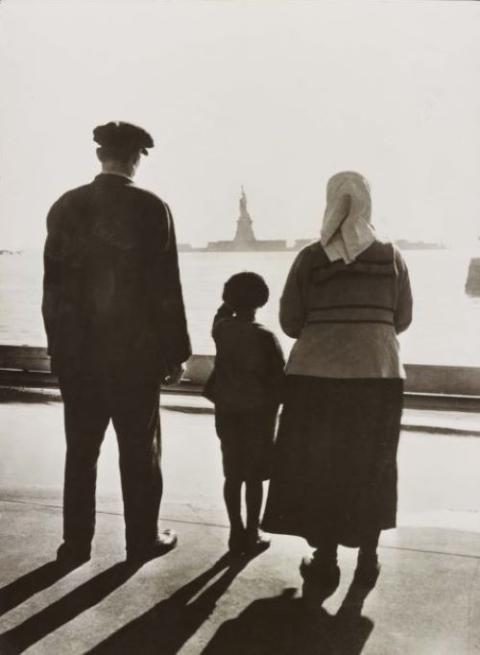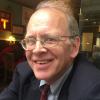
Immigrants wait at Ellis Island to be transferred Oct. 30, 1912. (PBS/ Library of Congress)
"Jews will not replace us." In one of the more jarring and ugly manifestations of antisemitism in recent American history, in August 2017, a fervid band of white males, brandishing Tiki torches, chanted that phrase as they marched through the streets of Charlottesville, Virginia, home of the University of Virginia, which Thomas Jefferson established in 1819.
"The U.S. and the Holocaust" reminds us these distressing attitudes run deep in the American consciousness, and this animosity toward the Jewish people complicated and attenuated our efforts to stop Nazism and rescue European Jews from the Holocaust. Six million Jews between 1941 and 1945.
Vital history but artistically unsatisfying, the six-hour documentary, directed and produced by Ken Burns, Lynn Novick and Sarah Botstein, and written by Geoffrey Ward, will air in three parts on Sept. 18, Sept. 19 and Sept. 20.
Following documentaries such as "Muhammad Ali" (2021) and "Country Music" (2019), this presentation maintains PBS' tradition: showcasing a film by prolific documentarian Burns and his collaborators to inaugurate its fall TV season.

The Statue of Liberty seen from Ellis Island (PBS/Library of Congress)
Burns co-directs and produces the film with frequent collaborator Novick. Often working on Burns' films as a producer, Botstein again serves in that role but also co-directs, her first time in that capacity.
Character actor and octogenarian Peter Coyote ("Benjamin Franklin") returns for the 11th time as the narrator of a Burns film. Notable actors, including Adam Arkin, Meryl Streep and Paul Giamatti, also voice historical figures.
Informed by the United States Holocaust Memorial Museum's "Americans and the Holocaust" exhibition, "The U.S. and the Holocaust" deconstructs the myth the Statue of Liberty always awaits newcomers with her lamp lifted "besides the golden door!" as Jewish poet and refugee advocate Emma Lazarus wrote in her 1883 poem "The New Colossus" which appears on a plaque inside the statue's pedestal.
Our history, the documentarians correctly argue, tells a different story. "The exclusion of people and shutting them out has been as American as apple pie," says Northwestern University emeritus history professor Peter Hayes. In the early 20th century, an immigration surge shaped this nativism.
‘The exclusion of people and shutting them out has been as American as apple pie.’
—Peter Hayes
By 1910, the documentarians note, the Jewish population in New York City was more than 1.25 million of the city's populace. As the ranks of the newly arrived rose in America, notable turn of the 20th century Americans such as birth control proponent Margaret Sanger, Alexander Graham Bell, and Helen Keller embraced eugenics.
Rooted in the fears that darker people would replace the white race, this putative science believed a superior race could be engineered through discouraging Jews, Blacks, gays and lesbians, gypsies and people with intellectual disabilities from having children.
Gaining traction after Germany's humiliating defeat in the great war, Adolf Hitler's Nazi party enthusiastically adopted eugenics, which informed their persecution of the Jews.
The documentary refutes the common misperception that Americans weren't well informed about Nazi atrocities. U.S. papers, the documentarians note, ran 3,000 stories in the first 100 days of Nazi rule (Hitler was appointed Germany's chancellor Jan. 30, 1933, but didn't become der führer, or "the leader," until August 1934.)
Rabbi Stephen Wise organized the first American mass rally against the Nazis, which drew 55,000 protesters to Madison Square Garden March 27, 1933. This was a decidedly minority view, however. A poll taken in 1938, according to historian Daniel Greene, revealed 66% of Americans believed the persecution of the Jews was their own fault.
The antisemitism of prominent Americans such as Catholic priest Charles Coughlin and aviation hero Charles Lindbergh doubtlessly influenced these attitudes. Like many Americans of that era, "Lucky Lindy" was an isolationist, who became the America First movement's leader and waged, Ward writes, "a 27-month bitter struggle" to keep us out of World War II.
Less than two months before America entered the war, on Sept. 11, 1941, Lindbergh gave an infamous speech in Des Moines, Iowa, which blamed "the British, the Jewish [sic] and the Roosevelt Administration" for drawing the United States into the war. Because of his inflammatory rhetoric, Liberty Magazine called the hero "the most dangerous man in America."

Immigrants carry luggage, Ellis Island, New York. (PBS/Library of Congress)
The filmmakers emphasize Lindbergh's role promoting antisemitism, but they should have paid more attention to Coughlin.
In a 1994 PBS American Experience film, "America and the Holocaust," director and writer Martin Ostrow says Coughlin "was the most influential anti-Semite."
Donald Warren, author of Radio Priest: Charles Coughlin, The Father of Hate Radio, commented in a 1996 C-Span interview that at his peak in the 1930s, the Michigan priest drew an audience of 30-40 million — a quarter to a third of the American population — to his Sunday afternoon radio program
Antisemitism, the filmmakers observe, also influenced public policy and government inaction, which hindered efforts to save refugees.
In part a reaction to Jewish immigration and passed in 1924, the Johnson-Reed Act placed strict quotas upon and required visas from Eastern European immigrants aspiring to resettle in America. Given the demand and limited number of visas, the wait to obtain one, without outside intervention, would likely have taken 11 years, the documentarians say.
According to the filmmakers, the state department's antisemitism created an extra barrier for these desperate souls. Embodying these attitudes, Assistant Secretary of State Breckinridge Long oversaw the visa program. Serving in Congress for 50 years, the Jewish lawmaker Emanuel Celler said of him: "the tempest tossed get little comfort from men like Breckenridge Long."
Despite growing pressure to do more to help refugees, the Franklin Roosevelt administration resisted amending the quota system until a Treasury Department investigation of the State Department. Led by Jewish Secretary of Treasury Henry Morgenthau, the inquiry discovered Long suppressed reports from Gerhart Riegner of the Jewish World Congress to the department about German mass murder.
The investigation engendered the War Refugee Board's formation in January 1944. They supported Swedish businessman Raoul Wallenberg, who was instrumental in rescuing 120,000 Jews in Budapest, Hungary. The documentarians say the United States took in more Jewish refugees than all other countries — 225,000 — during the war, but in their correct judgment, we could have done better.
"The U.S and the Holocaust" reports an undeniably powerful, important story. Hearing from Eva Geiringer, Anne Frank's neighbor in Amsterdam, who astonishingly survived the Shoah, edifies. But the heartbreaking tale of writer Daniel Mendelsohn's lookalike great uncle Shmiel, who wasn't as lucky, haunts.
Advertisement
Still, especially to veteran observers of Burns' work, there's something amiss with the documentary. Mini-biographies of pivotal figures usually provide the signature moments in Burns' films. Marrying striking photographs with music and Coyote's inimitable, sonorous narration, this filmmaking captivates audiences.
This documentary unfortunately features few scenes of this resonance. Varian Fry's story is a welcome exception. On behalf of the Emergency Rescue Committee, the 32-year-old, Harvard-educated foreign correspondent arrived in Marseilles, France, in 1940 with "$3,000 in cash strapped to his leg," Ward memorably writes.
Working, Fry says, with "his partner in the crime of saving lives" American consul Hiram Bingham, they rescued 2,000 refugees, including artists Marc Chagall, Piet Mondrian and philosopher Hannah Arendt.
More narratives like these would have made the film more compelling. "The U.S. and the Holocaust's" value, however, derives from what it teaches.
Distinguished Princeton University emeritus history professor Nell Painter sums up the film's chief lesson. In American society, she says, there's a "stream of white supremacy and antisemitism. It's a big stream and it always bubbles up."






